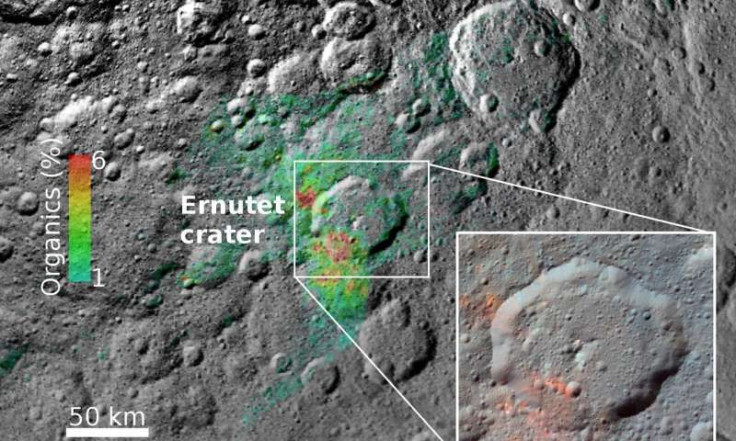NASA Finds Organic Material On Dwarf Planet Ceres Could Be Locally Produced

NASA's Dawn space probe detected the presence of organic materials on Ceres — a dwarf planet in the main asteroid belt between Mars and Jupiter — in February. Since this discovery, the Southwest Research Institute (SwRI) has been analyzing the data and trying to theorize a model for its origin. The main question here was if the organic material originated on Ceres or was transported there by an asteroid.
Simone Marchi, a principal scientist at SwRI said in a release that this discovery poses an interesting question. The team, who discussed their findings at a press conference at the American Astronomical Society's 49th Division for Planetary Sciences Meeting in Provo, Utah, on Monday, said that both situations that were being considered had their shortcomings.
Dwarf planet Ceres is dated back to a period about 4.5 billion years ago at the dawn of our solar system. According to a press release on SwRI’s official website, studying its organics can help explain the "the origin, evolution, and distribution of organic species across the solar system."
The very location of Ceres at the boundary between the inner and outer solar system, between Mars and Jupiter, give it an "intriguing composition characterized by clays, sodium-carbonates and ammonium-carbonates, suggest a very complex chemical evolution. The role of organics in this evolution is not fully understood, but has important astrobiological implications," said the press release.
A study based on the geology of the organic material-dense regions on Ceres drew blanks regarding its origin. This earlier research focused on the geology of the organic-rich region on Ceres was inconclusive about their origin, Marchi said. "Recently, we more fully investigated the viability of organics arriving via an asteroid or comet impact."
The focus was shifted towards studying impact parameters of asteroids on the surface of the dwarf planet. Asteroid sizes and velocities were calculated using the iSALE shock physics code simulations. But, these simulations revealed that collisions at such a great force will almost certainly destroy all organic matter.
High-velocity impact collisions were effectively ruled-out as the means of transportation of organic matter. A phenomenon known as shock compression is responsible for the destruction of organic material during collisions. It is possible for "low-velocity impact asteroids to retain between 20 and 30 percent of their pre-impact organic material during delivery, especially for small impactors at oblique impact angles.” But, the spatial distribution of organics on Ceres shows that this is not possible.
So by ruling out organic matter from asteroids, the team has concluded that the organic matter originated on the planet. Further study will give us data about the nature of the material and help us understand the nature of its origin.
Dawn’s mission to Ceres is managed by the Jet Propulsion Laboratory for NASA’s Science Mission Directorate in Washington, D.C., and is a project of the directorate’s Discovery Program. The functioning of this mission is managed from and by NASA’s Marshall Space Flight Centre in Huntsville, Alabama. Dawn is NASA’s first interplanetary space probe. It was launched in 2007 for a mission involving extended stays at two extraterrestrial bodies: giant asteroid Vesta and dwarf planet Ceres. The spacecraft is currently in the main asteroid belt studying the two objects.
© Copyright IBTimes 2024. All rights reserved.





















